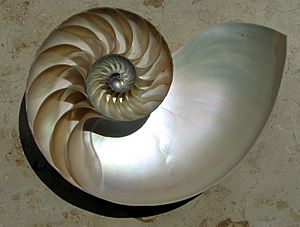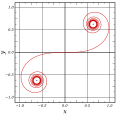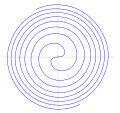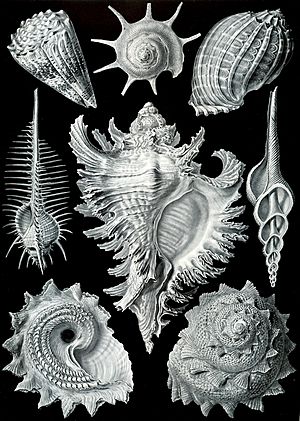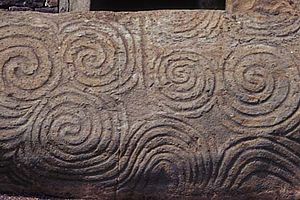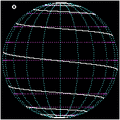Spiral facts for kids
A spiral is a special curved shape in mathematics. Imagine a line that starts at a central point. Then, it winds around that point, getting further and further away as it goes.
This is different from a circle, where every point is always the same distance from the center. A spiral is an "open" curve, meaning it doesn't connect back to its starting point. Circles and ellipses, on the other hand, are "closed" curves.
Contents
What are Two-Dimensional Spirals?
A two-dimensional spiral is a flat spiral. You can draw it on a piece of paper. We can describe these spirals using special math rules that tell us how far the curve is from the center as it turns.
Some important types of flat spirals include:
- The Archimedean spiral: This spiral keeps the same distance between its turns.
- The Euler spiral (also called Cornu spiral or clothoid): This one is used in engineering, like designing roads.
- Fermat's spiral: This spiral gets wider faster as it turns.
- The hyperbolic spiral: This spiral gets closer to the center as it turns more.
- The lituus: This spiral also gets closer to the center as it turns.
- The logarithmic spiral: This spiral gets wider by the same amount each time it turns. You can find it a lot in nature!
- The Fibonacci spiral and golden spiral: These are special types of logarithmic spirals. They are connected to the Fibonacci sequence and the golden ratio.
- The Spiral of Theodorus: This spiral is made by connecting many right triangles.
What are Three-Dimensional Spirals?
Three-dimensional spirals are shapes that go up or down as they turn. Think of a spring or a corkscrew.
- A helix is a common 3D spiral. It looks like a coil, like the shape of a Slinky toy or the threads on a screw.
- A vortex is also a type of 3D spiral, like the swirling shape of water going down a drain or a tornado.
- A conic helix is a spiral that winds around the surface of a cone.
Spirals in Nature
Spirals are everywhere in nature! Scientists have studied them for a long time.
Many shells of sea creatures, like the nautilus, grow in a logarithmic spiral shape. This means the shell keeps the same shape as it grows bigger. Scientists like D'Arcy Wentworth Thompson explained how shells are formed by a curve that spins around an axis, growing larger in a steady way. Some shells, like the nautilus, grow flat, while others, like many snails, grow in a twisted spiral.
You can also see spirals in:
The way seeds are arranged in a sunflower head is a great example of a spiral. The florets (small flowers) grow in spirals that follow a special mathematical pattern. This pattern helps the plant pack the most seeds into the smallest space.
Some people also see the spiral as a symbol of infinity. It starts at one point and goes outward forever, like the universe.
Spirals as Symbols
The spiral is a very old and important symbol. You can find it in ancient art all over the world.
- It appears in megalithic art, like the famous carvings at the Newgrange tomb in Ireland. The triple spiral is a well-known example.
- In ancient Chinese art, simple spirals might have been a symbol for the sun.
- Because spirals are found at many ancient burial sites, they likely represented the "life-death-rebirth" cycle. People thought the sun was "born" each morning and "reborn" the next, just like the spiral's continuous motion.
Spirals are also used to symbolize hypnosis. This comes from movies and cartoons where characters are hypnotized by staring into a spinning spiral. They can also show that a cartoon character is dizzy.
In science, the spiral shape is important for showing the double helix structure of DNA, which represents biological evolution. And, of course, many galaxies in space have a beautiful spiral shape!
Images for kids
-
Bowl on stand, Vessel on stand, and Amphora. From the Cucuteni Culture, 4300-4000 BCE. Found in Scânteia, Iași, Romania.
See also
 In Spanish: Espiral para niños
In Spanish: Espiral para niños


